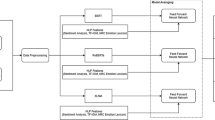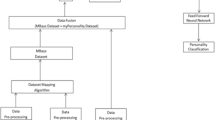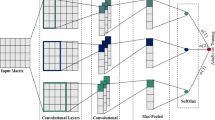Abstract
Personality is an important psychological construct accounting for individual differences in people. Computational personality recognition from online social networks is gaining increased research attention in recent years. However, the majority of existing methodologies mainly focused on human-designed shallow statistical features and didn’t make full use of the rich semantic information in user-generated texts, while those texts are exactly the most direct way for people to translate their internal thoughts and emotions into a form that others can understand. This paper proposes a deep learning-based approach for personality recognition from text posts of online social network users. We first utilize a hierarchical deep neural network composed of our newly designed AttRCNN structure and a variant of the Inception structure to learn the deep semantic features of each user’s text posts. Then we concatenate the deep semantic features with the statistical linguistic features obtained directly from the text posts, and feed them into traditional regression algorithms to predict the real-valued Big Five personality scores. Experimental results show that the deep semantic feature vectors learned from our proposed neural network are more effective than the other four kinds of non-trivial baseline features; the approach that utilizes the concatenation of our deep semantic features and the statistical linguistic features as the input of the gradient boosting regression algorithm achieves the lowest average prediction error among all the approaches tested by us.




Similar content being viewed by others
Explore related subjects
Discover the latest articles, news and stories from top researchers in related subjects.References
Vinciarelli A, Mohammadi G (2014) A survey of personality computing. IEEE Trans Affect Comput 5 (3):273–291. https://doi.org/10.1109/taffc.2014.2330816
Funder DC (2001) Personality. Annu Rev Psychol 52:197–221
Allport GW (1937) Personality: a psychological interpretation. Henry Holt, New York
Xue D, Hong Z, Guo S, Gao L, Wu L, Zheng J, Zhao N (2017) Personality recognition on social media with label distribution learning. IEEE Access 5:13478–13488
Celli F, Lepri B, Biel JI, Gatica-Perez D, Riccardi G, Pianesi F (2014) The workshop on computational personality recognition 2014. In: ACM conference on multimedia, Orlando, November 3–7, 2014. ACM, pp 1245–1246
Zhang L, Huang XL, Liu TL, Li A, Chen ZX, Zhu TS (2014) Using linguistic features to estimate suicide probability of Chinese microblog users. In: Human centered computing. Springer, pp 549–559
Celli F, Rossi L (2012) The role of emotional stability in Twitter conversations. In: Workshop on semantic analysis in social media, Avignon, 23–27 April 2012. Association for Computational Linguistics, pp 10–17
Roshchina A, Cardiff J, Rosso PA (2011) Comparative evaluation of personality estimation algorithms for the twin recommender system. In: 3th international workshop on search and mining user-generated contents, Glasgow, October 28 2011. ACM, pp 11–17
Enos F, Benus S, Cautin RL, Graciarena M, Hirschberg J, Shriberg E (2006) Personality factors in human deception detection: comparing human to machine performance. In: INTERSPEECH 2006 and 9th international conference on spoken language processing, Pittsburgh, Pennsylvania, 17–21 September. DUMMY PUBID
Luyckx K, Daelemans W (2008) Personae: a corpus for author and personality prediction from text. In: 6th international conference on language resources and evaluation, Marrakech, 28–30 May 2008, pp 2981–2987
Golbeck J, Hansen D (2011) Computing political preference among twitter followers. In: Proceedings of the SIGCHI conference on human factors in computing systems. ACM, pp 1105–1108
Celli F, Pianesi F, Stillwell D, Kosinski M (2013) Workshop on computational personality recognition: shared task. In: 7th international AAAI conference on weblogs and social media. Boston, Jul 8–11
Nie D, Guan ZD, Hao BB, Bai ST, Zhu TS (2014) Predicting personality on social media with semi-supervised learning. In: IEEE/WIC/ACM international joint conferences on web intelligence and intelligent agent technologies -volume 02, Warsaw, August 11–14, 2014. IEEE Computer Society, pp 158–165
Farnadi G, Sitaraman G, Sushmita S, Celli F, Kosinski M, Stillwell D, Davalos S, Moens MF, De Cock M (2016) Computational personality recognition in social media. User Model User-Adap Int 26 (2–3):109–142. https://doi.org/10.1007/s11257-016-9171-0
Schwartz HA, Eichstaedt JC, Kern ML, Dziurzynski L, Ramones SM, Agrawal M, Shah A, Kosinski M, Stillwell D, Seligman ME (2013) Personality, gender, and age in the language of social media: the open-vocabulary approach. PloS ONE 8(9):e73791
Polonsky M (2007) Online social networks and insights into marketing communications. J Internet Commer 6(4):55–72
Rosen PA, Kluemper DH (2008) The impact of the Big Five personality traits on the acceptance of social networking website. Paper presented at the 14th Americas Conference on Information Systems, Toronto
Schrammel J, Ffel C, Tscheligi M (2009) Personality traits, usage patterns and information disclosure in online communities. In: 23rd annual conference on human computer interaction, HCI 2009, Cambridge, UK, September 01–05, 2009. BCS Learning & Development Ltd, Swindon, pp 169–174
Selfhout M, Burk W, Branje S, Denissen J, Aken MV, Meeus W (2010) Emerging late adolescent friendship networks and Big Five personality traits: a social network approach. J Pers 78(2):509– 538
Li A, Yan Z, Zhu TS (2013) Self-report versus web-log: which one is better to predict personality of website users? Int J Cyber Behav Psychol Learn 3(4):44–54
Kosinski M, Stillwell D, Graepel T (2013) Private traits and attributes are predictable from digital records of human behavior. Proc Natl Acad Sci 110(15):5802–5805
Gosling SD, Augustine AA, Vazire S, Holtzman N, Gaddis S (2011) Manifestations of personality in online social networks: self-reported Facebook-related behaviors and observable profile information. Cyberpsychol Behav Soc Netw 14(9):483– 488
Golbeck J, Robles C, Turner K (2011) Predicting personality with social media. In: CHI’11 extended abstracts on human factors in computing systems, Vancouver, May 7–12, 2011. ACM, pp 253–262
Golbeck J, Robles C, Edmondson M, Turner K (2011) Predicting personality from Twitter. In: 2011 IEEE third international conference on privacy, security, risk and trust and 2011 IEEE third international conference on social computing, Boston, 9–11 Oct. 2011. IEEE, pp 149–156
Quercia D, Kosinski M, Stillwell D, Crowcroft J (2011) Our Twitter profiles, our selves: predicting personality with twitter. In: 2011 IEEE international conference on privacy, security, risk and trust and 2011 IEEE international conference on social computing, Boston, October 9–11, 2011. IEEE, pp 180–185
Farnadi G, Zoghbi S, Moens MF, De Cock M (2013) Recognising personality traits using Facebook status updates. In: Workshop on computational personality recognition at the 7th international AAAI conference on weblogs and social media, Boston, Massachusetts, July 8–11 2013. AAAI, pp 14–18
Alam F, Stepanov EA, Riccardi G (2013) Personality traits recognition on social network-Facebook. In: International conference on weblogs and social media, Cambridge, July 11 2013. AI Access Foundation, pp 6–9
Skowron M, Ferwerda B, Tkalčič M, Schedl M (2016) Fusing social media cues: personality prediction from Twitter and Instagram. In: 25th international conference companion on world Wide Web, April 11–15 2016, Montreal. ACM, pp 107–108
Hinton GE, Salakhutdinov RR (2006) Reducing the dimensionality of data with neural networks. Science 313(5786):504–507
Mikolov T, Sutskever I, Chen K, Corrado GS, Dean J (2013) Distributed representations of words and phrases and their compositionality. In: Advances in neural information processing systems, pp 3111–3119
Sridhar VKR (2015) Unsupervised text normalization using distributed representations of words and phrases. In: VS@ HLT-NAACL, pp 8–16
Poria S, Cambria E, Hazarika D, Vij P (2016) A deeper look into sarcastic tweets using deep convolutional neural networks. arXiv:161008815
Poria S, Cambria E, Gelbukh A (2016) Aspect extraction for opinion mining with a deep convolutional neural network. Knowl-Based Syst 108:42–49
Bahdanau D, Cho K, Bengio Y (2014) Neural machine translation by jointly learning to align and translate. arXiv:14090473
Xu K, Ba J, Kiros R, Cho K, Courville A, Salakhudinov R, Zemel R, Bengio Y (2015) Show, attend and tell: neural image caption generation with visual attention. In: International conference on machine learning, pp 2048–2057
Ioffe S, Szegedy C (2015) Batch normalization: accelerating deep network training by reducing internal covariate shift. In: International conference on machine learning, pp 448–456
Lai S, Xu L, Liu K, Zhao J (2015) Recurrent convolutional neural networks for text classification. In: AAAI, pp 2267–2273
Friedman JH (2001) Greedy function approximation: a gradient boosting machine. Ann Stat 29(5):1189–1232
Bai ST, Zhu TS, Cheng L (2012) Big-five personality prediction based on user behaviors at social network sites. arXiv:12044809
Bai ST, Hao BB, Li A, Yuan S, Gao R, Zhu TS (2013) Predicting big five personality traits of Microblog users. In: IEEE/WIC/ACM international conference on web intelligence and intelligent agent technology, pp 501–508. https://doi.org/10.1109/wi-iat.2013.70
Nie D, Li L, Zhu TS (2013) Conscientiousness measurement from Weibo’s public information. In: Zhou Z-H, Schwenker F (eds) Partially supervised learning: second IAPR international workshop, PSL 2013, Nanjing, China, May 13–14, 2013, Revised Selected Papers. Springer, Berlin, pp 58–67,https://doi.org/10.1007/978-3-642-40705-5_6
Li L, Li A, Hao BB, Guan ZD, Zhu TS, Liu C (2014) Predicting active users’ personality based on micro-blogging behaviors. PLoS ONE 9(1):e84997
Peng KH, Liou LH, Chang CS, Lee DS (2015) Predicting personality traits of Chinese users based on Facebook wall posts. In: 24th wireless and optical communication conference, Taipei, 23–24 Oct. 2015. IEEE, pp 9–14, https://doi.org/10.1109/WOCC.2015.7346106
Shlomo A, Moshe K, Dhawle S (2005) Pennebaker JW Lexical predictors of personality type. In: Joint annual meeting of the interface and the classification society of North America, St. Louis, 8–12 June
Mairesse F, Walker MA, Mehl MR, Moore RK (2007) Using linguistic cues for the automatic recognition of personality in conversation and text. J Artif Intell Res 30:457–500
Pennebaker JW, Booth RJ, Francis ME (2007) Linguistic inquiry and word count: LIWC [Computer software]. LIWC Net, Austin
Coltheart M (1981) The MRC psycholinguistic database. Q J Exp Psychol 33(4):497–505
Oberlander J (2006) Nowson S Whose thumb is it anyway? Classifying author personality from weblog text. In: COLING/ACL on main conference poster sessions, Sydney, Australia, July 17–18, 2006. Association for Computational Linguistics Stroudsburg, pp 627–634
Nowson S, Oberlander J (2007) Identifying more bloggers: towards large scale personality classification of personal weblogs. In: International conference on weblogs and social media, Boulder, Colorado, USA, March 26–28 2007. AAAI Press
Majumder N, Poria S, Gelbukh A, Cambria E (2017) Deep learning-based document modeling for personality detection from text. IEEE Intell Syst 32(2):74–79
Rangel F, Rosso P, Potthast M, Stein B, Daelemans W (2015) Overview of the 3rd author profiling task at PAN 2015. In: Conference and labs of the evaluation forum, Toulouse, September 8–11 2015. CEUR-WS.org
Yang Z, Yang D, Dyer C, He X, Smola AJ, Hovy EH (2016) Hierarchical attention networks for document classification. In: HLT-NAACL, pp 1480–1489
Glorot X, Bordes A, Bengio Y (2011) Domain adaptation for large-scale sentiment classification: a deep learning approach. In: Proceedings of the 28th international conference on machine learning (ICML-11), pp 513–520
LeCun Y, Boser BE, Denker JS, Henderson D, Howard RE, Hubbard WE, Jackel LD (1990) Handwritten digit recognition with a back-propagation network. In: Advances in neural information processing systems, pp 396–404
LeCun Y, Bottou L, Bengio Y, Haffner P (1998) Gradient-based learning applied to document recognition. Proc IEEE 86(11):2278–2324
Elman JL (1990) Finding structure in time. Cognit Sci 14(2):179–211
Hochreiter S, Schmidhuber J (1997) Long short-term memory. Neural Comput 9(8):1735–1780
Zhou C, Sun C, Liu Z, Lau F (2015) A C-LSTM neural network for text classification. arXiv:151108630
Szegedy C, Liu W, Jia Y, Sermanet P, Reed S, Anguelov D, Erhan D, Vanhoucke V, Rabinovich A (2015) Going deeper with convolutions. In: Proceedings of the IEEE conference on computer vision and pattern recognition, pp 1–9
Szegedy C, Ioffe S, Vanhoucke V, Alemi AA (2017) Inception-v4, inception-ResNet and the impact of residual connections on learning. In: AAAI, pp 4278–4284
Pennebaker JW, King LA (1999) Linguistic styles: language use as an individual difference. J Pers Soc Psychol 77(6): 1296
Tausczik YR, Pennebaker JW (2010) The psychological meaning of words: LIWC and computerized text analysis methods. J Lang Soc Psychol 29(1):24–54
Harris ZS (1954) Distributional structure. Word 10(2–3):146–162
Collobert R, Weston J (2007) Fast semantic extraction using a novel neural network architecture. In: Annual meeting-association for computational linguistics, vol 1, p 560
Mikolov T, Chen K, Corrado G, Dean J (2013) Efficient estimation of word representations in vector space. arXiv:13013781
Glorot X, Bordes A, Bengio Y (2011) Deep sparse rectifier neural networks. In: Proceedings of the fourteenth international conference on artificial intelligence and statistics, pp 315– 323
Srivastava N, Hinton GE, Krizhevsky A, Sutskever I, Salakhutdinov R (2014) Dropout: a simple way to prevent neural networks from overfitting. J Mach Learn Res 15(1):1929–1958
Le Q, Mikolov T (2014) Distributed representations of sentences and documents. In: International conference on international conference on machine learning, pp II–1188
Smola AJ, Schölkopf B (2004) A tutorial on support vector regression. Stat Comput 14(3):199–222
Breiman L (2001) Random forests. Mach Learn 45(1):5–32
Kingma D, Ba J (2014) Adam: a method for stochastic optimization. arXiv:14126980
Acknowledgements
This work was support by the scientific research funds of PLA (Grant No. AWS13J003). The authors would like to thank the anonymous reviewers for their careful review and constructive comments. Thanks also to David Stillwell, Michal Kosinski and the myPersonality project for their efforts on collecting the Facebook dataset.
Author information
Authors and Affiliations
Corresponding author
Rights and permissions
About this article
Cite this article
Xue, D., Wu, L., Hong, Z. et al. Deep learning-based personality recognition from text posts of online social networks. Appl Intell 48, 4232–4246 (2018). https://doi.org/10.1007/s10489-018-1212-4
Published:
Issue Date:
DOI: https://doi.org/10.1007/s10489-018-1212-4





